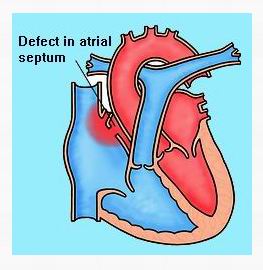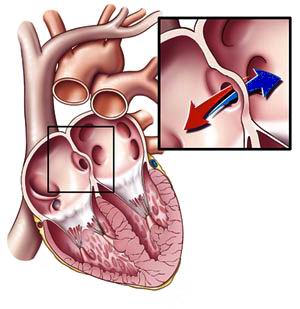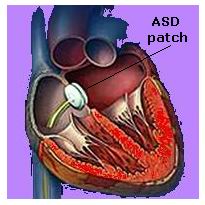
An Atrial Septal Defect (ASD) is a congenital heart defect where there is a hole in the wall (septum) between the two upper chambers (atria) of the heart. This hole allows blood to flow from the left atrium to the right atrium, which can lead to an increase in blood flow to the right side of the heart and lungs. In most cases, ASD is present at birth and can be diagnosed through imaging tests like echocardiograms or heart MRI scans.

ASD is typically a congenital condition, meaning it is present at birth. The exact cause is not always clear, but several factors may contribute to the development of ASD:
-
Genetic Factors: In many cases, ASD may run in families, suggesting a genetic predisposition. Certain genetic syndromes, such as Down syndrome, can increase the likelihood of developing ASD.
-
Environmental Factors: While not as common, certain maternal conditions during pregnancy, such as viral infections (rubella), or exposure to drugs or alcohol, can contribute to the development of ASD in the fetus.
-
Premature Birth: Children born prematurely may have an increased risk of developing ASD.
-
Other Heart Defects: ASD can be associated with other congenital heart defects, such as ventricular septal defects (VSD) or patent ductus arteriosus (PDA).

In some cases, the exact cause of the defect is unknown, and ASD develops without any apparent reason.
The symptoms of ASD can vary depending on the size of the hole in the heart and the amount of blood shunted to the right side of the heart. In many cases, small ASDs do not cause noticeable symptoms and may be discovered incidentally during routine health exams. However, larger ASDs or those left untreated can lead to the following symptoms:
-
Shortness of Breath: Individuals with ASD may experience shortness of breath, especially during physical activity or exertion. This is due to increased blood flow to the lungs.
-
Fatigue: People with ASD may feel unusually tired or fatigued, even after minimal physical activity, because the heart is working harder than normal.
-
Heart Palpitations: Some people with ASD may experience an irregular heartbeat, known as arrhythmia. This can cause sensations of the heart skipping beats or racing.
-
Swelling in Legs, Ankles, or Abdomen: As the right side of the heart becomes overloaded, fluid retention may occur, leading to swelling in the lower extremities or abdomen.
-
Frequent Respiratory Infections: Individuals with large ASDs are more prone to respiratory infections, such as pneumonia, due to increased blood flow to the lungs.
-
Stroke or Transient Ischemic Attack (TIA): In some cases, a blood clot can pass through the ASD from the right side of the heart to the left side, potentially causing a stroke or TIA.
The diagnosis of ASD is typically confirmed through a series of imaging tests, including:
-
Echocardiogram: This is the most common test used to diagnose ASD. It uses sound waves to create detailed images of the heart, allowing doctors to visualize the size and location of the hole in the septum.
-
Electrocardiogram (ECG or EKG): An ECG measures the electrical activity of the heart. In patients with ASD, an ECG may show signs of atrial enlargement or arrhythmias.
-
Chest X-ray: A chest X-ray can help identify any enlargement of the heart or lungs, which may be indicative of ASD.
-
Cardiac MRI: In some cases, doctors may use a cardiac MRI to obtain more detailed images of the heart's structure and function.
-
Transesophageal Echocardiogram (TEE): This test involves placing a probe in the patient's esophagus to get a clearer view of the heart's structures, especially in difficult-to-see areas.
-
Bubble Study: This is a specialized form of echocardiography, where saline bubbles are injected into a vein. If the bubbles cross from the right atrium to the left, it indicates the presence of an ASD.
The treatment for ASD generally depends on the size of the defect, the symptoms experienced, and the overall health of the patient. The primary goal is to close the hole and restore normal heart function. There are several treatment options for ASD closure:
-
Catheter-Based Closure: This is a minimally invasive procedure performed in a catheterization lab. A device (such as an Amplatzer Septal Occluder) is inserted through a catheter and guided to the heart to close the ASD. This approach is typically used for moderate-sized defects and has a faster recovery time.
-
Surgical Closure: If the ASD is too large or the catheter-based closure is not an option, traditional open-heart surgery may be required. The surgeon will sew the hole closed or use a patch to cover the defect. Surgery is typically done under general anesthesia and requires a longer recovery period.
-
Medications: While medications cannot close an ASD, they may be used to manage symptoms or prevent complications. For example, blood thinners may be prescribed to reduce the risk of clot formation and stroke.
-
Regular Monitoring: In some cases, particularly with small ASDs that do not cause symptoms, doctors may recommend regular monitoring to ensure the condition does not worsen.
Since ASD is a congenital condition, it cannot be prevented in the traditional sense. However, there are steps that individuals can take to manage their condition effectively and prevent complications:
-
Early Detection: Regular screening for heart conditions, especially for those with a family history of congenital heart defects, can help detect ASD early. Early intervention can prevent long-term complications.
-
Heart-Healthy Lifestyle: A healthy diet, regular exercise, and avoiding smoking or excessive alcohol consumption can improve overall heart health and reduce the risk of complications from ASD.
-
Medication Adherence: Individuals who have undergone ASD closure should adhere to prescribed medications, such as anticoagulants, to prevent blood clots.
-
Routine Follow-Up: Regular visits to a cardiologist are necessary to monitor heart function and ensure that the closure procedure was successful.
While ASD closure is generally effective, there are potential complications associated with both the condition itself and the treatment:
-
Heart Failure: If left untreated, ASD can lead to heart failure, as the right side of the heart becomes overloaded. Closure helps prevent this risk.
-
Stroke: If a clot passes through the ASD from the right to the left atrium, it can travel to the brain, causing a stroke. This is more common in larger defects.
-
Arrhythmias: Some people with ASD may develop arrhythmias, such as atrial fibrillation, following the closure procedure. This may require additional treatment.
-
Infection: Like any surgery or invasive procedure, there is a risk of infection at the insertion site or inside the heart.
-
Device or Surgical Complications: In rare cases, the closure device may shift, or the patch may not fully seal the defect, requiring additional intervention.
For those who have undergone ASD closure, it's important to continue living a heart-healthy lifestyle to maintain optimal heart function. Here’s how individuals can live with the condition:
-
Post-Procedure Care: After closure, patients may need to stay in the hospital for a few days for monitoring. Rest and gradual return to normal activities are recommended. Most people can return to their regular routine after a few weeks.
-
Emotional Support: Dealing with a congenital heart defect can be emotionally taxing. Support groups or counseling may help individuals cope with any feelings of anxiety or depression.
-
Physical Activity: Regular exercise is encouraged once the doctor clears the patient. Activities like walking, swimming, and cycling are usually safe after recovery, but high-intensity sports may be restricted.
-
Monitoring Heart Health: Regular check-ups with a cardiologist are essential to ensure the closure remains intact and that the heart is functioning properly.
-
Health Risks Management: People with ASD who have undergone closure should continue to manage other health risks, such as high blood pressure or cholesterol, to support overall cardiovascular health.
Few popular hospitals for Atrial Septal Defect Closure are:
Thailand, Malaysia, Singapore, Turkey and India are the most cost effective locations that offer up to almost 80% savings in comparison to the US.
SurgeryPlanet facilitates a plethora of services to the medical treatment traveler also which includes, a hassle free and discounted travel option, a welcome hand at the airport on arrival, travel in an air-conditioned car, round the clock service & support. Your medical evaluation is pre arranged with the least of waiting time. Once your assessment is complete and found medically fit, the procedure is immediately scheduled without a waiting period. Please read through our Services and Testimonials to understand and select your best options.
Atrial Septal Defect | Hole In The Heart | Pulmonary Hypertension | Chest Infection | Eisenmenger’s Syndrome | Cardiology | Cardiac Hospitals | Cardiac Procedures In Malaysia | Cardiac Procedures In India | Palpitations | Irregular Heartbeats | Catheterization | Cardiologist | Amplatzer | Primary Closure | Secondary Closure | ASD Diagnosis | ASD Recovery | Treatment For ASD | Hospitals For ASD | ASD In India | ASD In Malaysia | ASD In Thailand | ASD Risks | Surgery For ASD | Doctors For ASD | Cost Of ASD | Destinations For ASD | Surgeons For ASD | ASD Abroad | ASD Overseas | ASD Low Cost | ASD in SGH
SurgeryPlanet is an Healthcare Facilitator and not a Medical service provider. The information provided in this website is not to be used for diagnosis or treatment of any medical condition or use for any medical purposes. We provide information solely for medical travel facilitation and do not endorse any particular health care provider, hospital, facility, destination or any healthcare service or treatment listed. We are not an agent for, or affiliated to any health care provider, or service listed in our website and is not responsible for health care services provided by them. Choice of hospital or doctor for your healthcare services is your independent decision. Consult your domestic licensed health care provider before seeking the services of any health care provider you learn about from our website.


